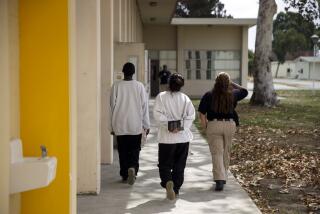Population Cap Ordered at S.D. Juvenile Hall
SAN DIEGO — The county Juvenile Hall is so desperately crowded that it is a “degrading, demeaning, dehumanizing setting” that abuses the basic rights of the children there, a San Diego Superior Court judge said Thursday, announcing he would order a cap on population levels.
In a tentative ruling on a class-action lawsuit, Judge Robert J. O’Neill said crowding at the hall threatens sanitary conditions, leads to assaults and undermines the hall’s central mission of rehabilitating wayward youngsters. Built for 219 youths, the Kearny Mesa facility commonly holds 400, and O’Neill said there simply must be a cap.
The financially strapped county claimed it is doing the best it can at Juvenile Hall with limited resources, but O’Neill said that simply is not good enough.
“The cart is dragging the horse,” O’Neill said. “The system is being driven by its limits, not by its mission.”
Saying he would issue a final ruling in favor of the American Civil Liberties Union and against the county, O’Neill left all details for that written order, which won’t be out for weeks.
The judge’s ruling apparently marks yet another victory for the ACLU in what has been a lengthy quest to ease crowding at the county’s jails.
The ACLU brought its first suit against the county in 1977, alleging that the downtown County Jail was overcrowded. In 1987, the ACLU filed a second suit, claiming overcrowding at five outlying jails.
The result of both Superior Court suits has been court-ordered caps on the inmate populations at the downtown jail and the five suburban facilities.
In 1990, the ACLU struck again, alleging in another suit filed in Superior Court that Juvenile Hall is so crowded that youths are being deprived of a “safe, decent living environment.”
The hall houses youths 10 to 17 years old. It is a temporary way station for a wide range of kids--those waiting for foster homes as well as gang-affiliated accused killers wending through the court system.
“This decision is very important because it underscores the basic principle that the constitutional rights of children can’t give way to fiscal expediency,” ACLU legal director Betty Wheeler said after the decision.
“When the government takes away the liberty of a child, it has not only a constitutional, but, I think, a moral obligation to provide minimally decent living conditions for that child,” Wheeler said. “We haven’t met that standard in this county for many years.”
Lawyers at the county counsel’s office, which handled the defense of the suit, were not available at the courthouse for comment and did not return phone calls later Thursday to their offices.
Under state law, a juvenile hall must be run “in all respects as nearly like a home as possible.”
But the county’s own records showed that Juvenile Hall has been severely crowded since 1979, according to court files.
At the Kearny Mesa hall, rooms designed for one child sleep three, the ACLU said. Some children spend the night on mattresses on the floor, it said.
At a trial that began in late November, witnesses testified to sexual assaults, gang fights, food shortages, creepy bugs--and even denial of the basic right to go to the bathroom.
The county responded that what was important was whether it was meeting state-mandated levels of exercise, food, showers, sanitation, supervision and medical care. County probation officials, who run the hall, were not “deliberately indifferent” to conditions, the county lawyers said.
O’Neill said Thursday, though, that conditions had so “degraded” over recent years that it has become “degrading” to stay at the hall.
“When you’ve got that many kids, getting them all to the bathroom, to the showers, is an enormous task in a building where there are no toilets in the rooms,” he said.
The county’s defense simply was bogus, O’Neill said, especially in light of a state law calling for a home-like hall.
For instance, it is hardly home-like to build padded rubber rooms and isolate suicidal or raging youths there, O’Neill said. “I’m confident that, if I did that to my kid in my house, (county social workers) would remove that kid from my custody,” O’Neill said.
Crowding at the hall leads to violence, O’Neill said. Though the county and ACLU disputed during the trial whether the hall recorded an increase in the rate of violence over the years, O’Neill said common sense should prevail, particularly when increasing numbers of youths at the hall are aligned with gangs.
“With three kids in a room for one, with a 4-inch by 14-inch window, locked in there for an hour to an hour and a quarter, to suspect that you’re not going to have violence or sexual assaults is to put your head in the sand,” O’Neill said.
The judge also said crowding threatens the education and support programs at the facility because staffers spend so much time moving large groups from place to place that there is little time left for learning or fun. “They go back and forth to their rooms, like yo-yos, 10 to 12 times a day,” he said.
The judge said he was “not prepared” Thursday to say what the population cap at the hall should be. Double-bunking, he said, “does not offend me,” but youths who ask for a single room for safety’s sake ought to be able to get one, he said.
O’Neill said he wanted hall officials to devise a “workable process” that quickly directs youths languishing there after final court hearings to their eventual destination.
More to Read
Sign up for Essential California
The most important California stories and recommendations in your inbox every morning.
You may occasionally receive promotional content from the Los Angeles Times.










